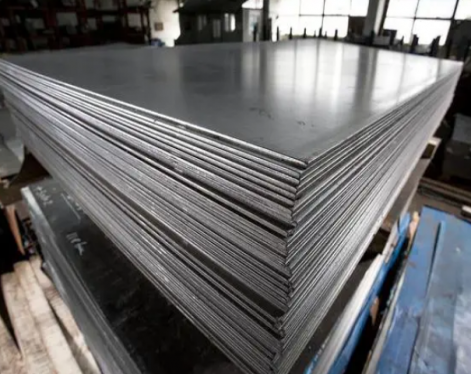The hardness range of commonly used stainless steel plates is approximately between 150-300HB.
Overview of stainless steel plate hardness:
The hardness of stainless steel plates refers to the material's ability to resist local plastic deformation. The surface of stainless steel plates with high hardness is not easy to be bent, cut or scratched. It also shows that it has high strength, good toughness and strong wear resistance.

Commonly used stainless steel plate hardness range:
1. Austenitic stainless steel
Austenitic stainless steel is the most commonly used stainless steel material, with a hardness range of approximately 150-300HB. It is often used to make high-strength machine parts. Among them, the highest hardness of austenitic stainless steel is HRC38-39.
Different types of stainless steel have different hardnesses. Here are some reference hardness values of stainless steel:
304 stainless steel: HB≤187
316 stainless steel: HB≤187
409 stainless steel: HB≤143
430 stainless steel: HB≤183
It should be reminded that the hardness value of stainless steel is affected by many factors, such as temperature, pressure, processing technology, etc. The hardness value is for reference only.
2. Ferritic stainless steel
Ferritic stainless steels have a lower hardness range, approximately between 100-220HB. Ferritic stainless steel has lower strength and toughness, but has better corrosion resistance and is often used to make tableware and kitchen utensils.
3. Martensitic stainless steel
Martensitic stainless steel has the highest hardness range and can reach over 600HB. Due to its excellent performance, it usually needs to be processed before use. Martensitic stainless steel is mostly used to make mechanical parts such as steel balls.
Factors affecting the hardness of stainless steel plates:
In addition to changing the hardness of the stainless steel plate by controlling the composition, material and processing technology during material preparation, its hardness is also affected by other factors.
1. Temperature
As the temperature increases, the hardness of the stainless steel sheet will decrease because the temperature will cause the atomic gaps to increase, resulting in a decrease in the strength of the material.
2. Deformation
When stainless steel sheets are cold or hot worked, their hardness increases. Because during the processing process, deformation and grain boundary slip will occur inside the material, resulting in a tight material structure and concentrated stress, thereby increasing its hardness.
Test method:
There are three commonly used methods to measure the hardness of stainless steel: Brinell hardness test, Rockwell hardness test and Vickers hardness test. Among them, Brinell hardness test is more common. The test method is to press the hardness meter on the surface of stainless steel and read the test value.
Conclusion:
The hardness of stainless steel plates is one of its basic properties, and different hardness values correspond to different uses. Manufacturers and users should start from their needs when purchasing stainless steel materials and choose stainless steel plates that suit their needs.
Read more: Carbon Steel Plate Hardness
Overview of stainless steel plate hardness:
The hardness of stainless steel plates refers to the material's ability to resist local plastic deformation. The surface of stainless steel plates with high hardness is not easy to be bent, cut or scratched. It also shows that it has high strength, good toughness and strong wear resistance.

Commonly used stainless steel plate hardness range:
1. Austenitic stainless steel
Austenitic stainless steel is the most commonly used stainless steel material, with a hardness range of approximately 150-300HB. It is often used to make high-strength machine parts. Among them, the highest hardness of austenitic stainless steel is HRC38-39.
Different types of stainless steel have different hardnesses. Here are some reference hardness values of stainless steel:
304 stainless steel: HB≤187
316 stainless steel: HB≤187
409 stainless steel: HB≤143
430 stainless steel: HB≤183
It should be reminded that the hardness value of stainless steel is affected by many factors, such as temperature, pressure, processing technology, etc. The hardness value is for reference only.
2. Ferritic stainless steel
Ferritic stainless steels have a lower hardness range, approximately between 100-220HB. Ferritic stainless steel has lower strength and toughness, but has better corrosion resistance and is often used to make tableware and kitchen utensils.
3. Martensitic stainless steel
Martensitic stainless steel has the highest hardness range and can reach over 600HB. Due to its excellent performance, it usually needs to be processed before use. Martensitic stainless steel is mostly used to make mechanical parts such as steel balls.
Factors affecting the hardness of stainless steel plates:
In addition to changing the hardness of the stainless steel plate by controlling the composition, material and processing technology during material preparation, its hardness is also affected by other factors.
1. Temperature
As the temperature increases, the hardness of the stainless steel sheet will decrease because the temperature will cause the atomic gaps to increase, resulting in a decrease in the strength of the material.
2. Deformation
When stainless steel sheets are cold or hot worked, their hardness increases. Because during the processing process, deformation and grain boundary slip will occur inside the material, resulting in a tight material structure and concentrated stress, thereby increasing its hardness.
Test method:
There are three commonly used methods to measure the hardness of stainless steel: Brinell hardness test, Rockwell hardness test and Vickers hardness test. Among them, Brinell hardness test is more common. The test method is to press the hardness meter on the surface of stainless steel and read the test value.
Conclusion:
The hardness of stainless steel plates is one of its basic properties, and different hardness values correspond to different uses. Manufacturers and users should start from their needs when purchasing stainless steel materials and choose stainless steel plates that suit their needs.
Read more: Carbon Steel Plate Hardness









